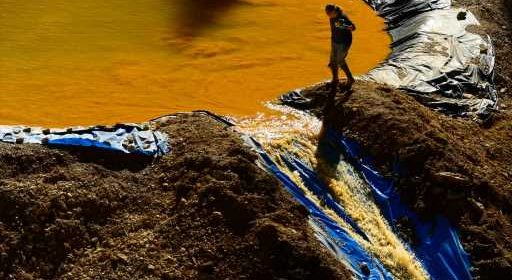Colorado reaches $1.6 million settlement over 2015 Gold King Mine blowout

The Sunnyside Gold Corporation will pay $1.6 million to settle environmental damage claims connected to the 2015 Gold King Mine spill that released a yellow plume of heavy metals into the Animas River, the Colorado Attorney General’s Office announced Monday.
The agreement, which isn’t yet finalized, stipulates that the money must go toward restoration projects within the Bonita Peak Mining District Superfund Site, attorney general spokesman Lawrence Pacheco said in a news release. It would also release the corporation from additional liability with the state moving forward.
The $1.6 million settlement marks the latest in a series of such agreements stemming from the Gold King Mine spill. Sunnyside agreed earlier this year to pay $10 million to the Navajo Nation and $11 million to New Mexico.
The newly announced settlement doesn’t amount to much money when compared to the millions that already have been spent in the area, said Peter Butler, chair of the Bonita Peak Mining District Community Advisory Group. Most of that money went toward attorneys and consultants trying to determine liability rather than actual cleanup efforts, he said.
“I think all the different parties spent close to $70 million in the last five years,” said Butler, a Durango resident. “Not much cleanup effort, though, almost all study. And there’s been almost no improvement in water quality.”
Butler added that he’s not surprised the settlement is so small. Part of that could be, he said, because Sunnyside has cooperated well with cleanup efforts. Another part of that could be because of the complicated liability issues surrounding the Gold King Mine spill.
A cleanup crew led by the Environmental Protection Agency inadvertently triggered the 3-million-gallon spill and The Denver Post reported in 2016 that the agency official overseeing the work knew of the blowout danger well beforehand.
The spill sent at least 880,000 pounds of metals into the Animas River, through three states and across the land of two Native American tribes.
“It’s an interesting, tangled web of liability up there,” said Marcel Gaztambide, who also sits on the advisory group with Butler.
The Sunnyside Gold Corporation did not own the Gold King Mine nor was the corporation responsible for the 2015 spill, Gina Myers, director of the company’s reclaiming operations, said in an email.
Rather, Butler said, Sunnyside installed concrete bulkheads downstream from the mine, which raised water levels in the area, making the spill worse.
For those in the area in August 2015, the spill was horrifying, Gaztambide said.
“The entire river turned bright orange,” said Gaztambide, who was not in town at the time. “There was a lot of concern for the fish in the river system.”
And there was more concern still for the farmers downstream whose crops rely on that water, Gaztambide said.
“But for the folks that knew the most about the Animas River, it wasn’t a big surprise,” Gaztambide added. “We’ve known about the problem of acid mine drainage for a long time.”
He called the 2015 blowout a symptom of a much larger problem of abandoned mines in the area. Research into the environmental damage caused by the spill and the other mines continues, Gaztambide added, so it’s difficult to say whether $1.6 million is enough.
For context, Butler said the EPA is currently cleaning drainage coming out of the mine, and operating that treatment plant costs about $2.5 million a year.
“So $1.6 million wouldn’t even run that for a year,” he said.
Still, Gaztambide said the money can be put to good use in what amounts to a massive cleanup project within which much work remains.
In a statement, Attorney General Phil Weiser called the settlement a “step in the right direction to address the damage suffered in southwest Colorado and the Four Corners region.”
If the settlement is finalized, Colorado Natural Resources Trustees will use the money for projects meant to restore damage from the 2015 spill and other hazardous releases in the area, Pacheco said.
The agreement itself will be filed Monday in U.S. District Court in Denver, starting a 30-day public comment process. The judge overseeing the case will then consider the agreements and comments submitted before deciding whether to accept the settlement.
Source: Read Full Article
